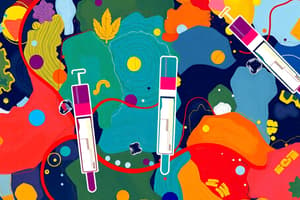Podcast
Questions and Answers
What is a characteristic feature of Type 1 diabetes?
What is a characteristic feature of Type 1 diabetes?
- It accounts for the majority of diabetes cases.
- The body's immune system destroys insulin-producing cells. (correct)
- It is preventable with proper lifestyle changes.
- It is primarily caused by environmental factors.
Which of the following is a common complication of uncontrolled diabetes?
Which of the following is a common complication of uncontrolled diabetes?
- Higher risk of heart disease (correct)
- Increased body weight
- Reduced glucose levels in the blood
- Decreased production of insulin
Which demographic is at the highest risk of developing Type 2 diabetes?
Which demographic is at the highest risk of developing Type 2 diabetes?
- Adults under 30 years old
- Caucasians living in urban areas
- Individuals with a family history of diabetes (correct)
- Pregnant women without risk factors
What defines gestational diabetes mellitus (GDM)?
What defines gestational diabetes mellitus (GDM)?
Which of the following regularly monitored blood sugar levels indicates diabetes?
Which of the following regularly monitored blood sugar levels indicates diabetes?
What is the recommended primary prevention method for Type 2 diabetes?
What is the recommended primary prevention method for Type 2 diabetes?
How much does physical activity reduce the risk of gestational diabetes mellitus (GDM)?
How much does physical activity reduce the risk of gestational diabetes mellitus (GDM)?
In the Diabetes Prevention Program, what was the percentage reduction in diabetes risk for the lifestyle intervention group?
In the Diabetes Prevention Program, what was the percentage reduction in diabetes risk for the lifestyle intervention group?
What is the normal range for HgA1c percentage?
What is the normal range for HgA1c percentage?
Which dietary change was associated with a 26% reduction in the risk of GDM?
Which dietary change was associated with a 26% reduction in the risk of GDM?
Flashcards
Type 1 Diabetes
Type 1 Diabetes
A type of diabetes where the body's immune system attacks and destroys the insulin-producing cells in the pancreas.
Type 2 Diabetes
Type 2 Diabetes
The most common type of diabetes, where the body produces insulin but doesn't use it properly, causing glucose to build up in the blood.
Gestational Diabetes
Gestational Diabetes
A type of diabetes that develops during pregnancy and usually resolves after childbirth.
Diabetes Symptoms
Diabetes Symptoms
Signup and view all the flashcards
Diabetes Risk Factors
Diabetes Risk Factors
Signup and view all the flashcards
Type 2 Diabetes Prevention
Type 2 Diabetes Prevention
Signup and view all the flashcards
HgA1c
HgA1c
Signup and view all the flashcards
Gestational Diabetes Prevention
Gestational Diabetes Prevention
Signup and view all the flashcards
Prediabetes Prevention Program
Prediabetes Prevention Program
Signup and view all the flashcards
Diabetes Prevention (Lifestyle Change)
Diabetes Prevention (Lifestyle Change)
Signup and view all the flashcards
Study Notes
Diabetes Mellitus
- A metabolic disease where the body's inability to produce enough insulin causes elevated glucose levels.
Types of Diabetes
- Type 1: Usually diagnosed in children and young adults. The body's immune system destroys insulin-producing cells. Not preventable. Approximately 5% of all cases.
- Type 2: Most common form (about 90% of cases). Body produces insulin but does not use it properly. Glucose doesn't move into cells, causing a build-up in the bloodstream. Often preventable.
- Gestational diabetes: Occurs during pregnancy. Increased risk for type 2 diabetes later. 18 out of every 100 pregnant women get GDM.
- Prediabetes: Elevated blood sugar levels, but not high enough for a diagnosis of diabetes. A higher risk of developing type 2 diabetes in the future.
Symptoms of Diabetes
- Excessive thirst and frequent urination
- Increased appetite and unusual weight loss or gain
- Fatigue
- Nausea or vomiting
- Blurred vision
- Frequent yeast or vaginal infections
- Slow-healing sores or cuts
- Skin itching, especially in groin or vaginal area
- Sudden weight loss
- Frequent urination
- Always hungry
- Wounds that won't heal
- Blirry vision
- Sexual problems
- Always thirsty
- Vaginal infections
- Numb or tingling hands or feet
Signs and Symptoms of Type 1 Diabetes
- Polyuria (frequent urination)
- Polydipsia (extreme thirst)
- Polyphagia (extreme hunger)
- Weight loss
- Fatigue
- Increased frequency of infections
- Rapid onset
- Insulin-dependent
- Early onset (often before age 20)
Type 2 Diabetes
- Most common type
- Body produces insulin but doesn't use it properly
- Glucose accumulates in the bloodstream
- Often preventable
Components of Type 2 Diabetes
- Insulin resistance
- Beta-cell dysfunction
Risk Factors
- Genetics
- Family history
- Polycystic ovary syndrome
- Irregular menses
- Race (African Americans, Hispanics, Asians > whites)
- Age (after age 45, but increasingly younger)
- Environmental factors
- Inactivity
- Weight gain
Gestational Diabetes Mellitus (GDM)
- Diabetes during pregnancy
- Family history of diabetes or being overweight before pregnancy
- Giving birth to a baby >9lbs
- 18 out of every 100 pregnant women get GDM
- High blood glucose in mother
- Baby gaining extra weight due to increased glucose in the mother
Complications of Uncontrolled Diabetes
- Heart disease
- Stroke
- Kidney failure
- Blindness
- Nerve damage
- Amputation
- Wound that does not heal
- Cardiovascular disease
- Stroke
- Heart attack
- Loss of circulation in arms and legs
Monitoring Diabetes
- Blood samples taken from a finger prick
- Strips are put into blood glucose meter
- Recording blood glucose levels allows for changes in treatment and lifestyle changes
Prevention of Diabetes
- Type 1: Currently not preventable. Research continues on preventing further beta cell destruction.
- Type 2: Primary prevention involves maintaining a healthy lifestyle (diet and exercise). Secondary prevention involves checking HbA1c (average blood sugar over three months). Tertiary prevention involves ongoing exercise and proper diet.
- Gestational diabetes: Active lifestyle before and after pregnancy can reduce risk by about 70%. Higher fiber diets reduce the risk by 26%.
U.S. Prevalence of Diabetes
- 29.1 million people
- 1 out of every 11 people
- Undiagnosed cases still exist
Global Prevalence of Diabetes
- 387 million people worldwide
- Continued expected increase
Prediabetes
- 86 million people
- 9 out of 10 do not know they have it
- 15-30% may develop type 2 within 5 years
Diabetes Prevention Program (Type 2)
- Lifestyle intervention group vs. medicated group (with Metformin) vs placebo.
- Lifestyle intervention reduced diabetes by 58%.
- Metformin reduced diabetes by 31%.
- Effective for both sexes (25-44 years old) and BMI of 30+.
Treatment of Type 2 Diabetes
- Monotherapy: Usually begin with a healthy lifestyle change.
- Combination Therapy: Often added medication is needed to manage glucose
- Initial treatment depends on individual factors like age, obesity, genetics etc.
- Different drugs (oral/insulin) can be used in treatment
Websites
- Include links
Questions?
Studying That Suits You
Use AI to generate personalized quizzes and flashcards to suit your learning preferences.





